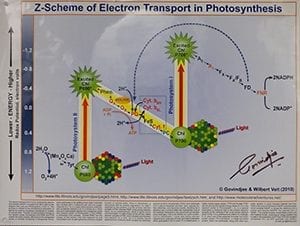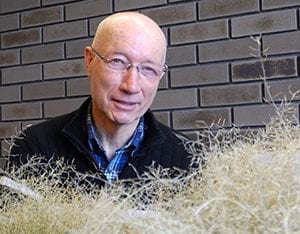News
Of Spray Paint and Plant Stress
What do graffiti and plants under stress have in common?
Both can bleach in the sun and lose their color, due to the energy absorbed by their pigments, and the oxygen in the surrounding air. A graffiti artist can always paint over a faded masterpiece, but the consequences for plants can be far more serious.
When plants absorb sunlight with their chlorophyll pigments to perform photosynthesis, they first take electrons from water and pass them along a chain of different proteins. But a stressful situation, such as a drought, too much light or low temperatures can disrupt the chain, leaving the plant pigments holding the electrons and absorbed light energy—almost like a molecular game of hot potato.
Those energized pigments become “photosensitizers” and can shed the absorbed light energy or allow electrons to be passed onto oxygen molecules in the cell, creating special forms of oxygen called reactive oxygen species. Also called ROS, these oxygen molecules are unstable, and can attack vital structures within the cell.
“The pigments put on the wall are also photosensitizers,” said BTI Professor Klaus Apel. They give rise to ROS that will react with the paint, breaking apart the pigments themselves. This reaction is what causes the paint to fade, said Apel.
 Back in plants, these ROS arise due to all kinds of stressful situations that disrupt photosynthesis, such as temperatures that are too low or too high, too much light or too little water. When the ROS react with other molecules inside the cell, they appear to wreak havoc, like a rock star in a hotel room. The plants wilt, stop flowering and their leaves bleach.
Back in plants, these ROS arise due to all kinds of stressful situations that disrupt photosynthesis, such as temperatures that are too low or too high, too much light or too little water. When the ROS react with other molecules inside the cell, they appear to wreak havoc, like a rock star in a hotel room. The plants wilt, stop flowering and their leaves bleach.
Scientists have long thought that ROS were dangerous—to plants, paint and humans. Some believe that ROS damage or kill the cells in people, leading to aging and contributing to heart disease and Alzheimer’s. To counter the damaging effects of ROS, some doctors have recommended antioxidants that block their activities. Entire shelves at the pharmacy are devoted to a variety of vitamins and food supplements purported to stop the destruction.
But cells even have their own natural metabolites and proteins that act as antioxidants to regulate ROS concentrations in the cell. And Apel was suspicious of the blanket idea that all ROS simply cause damage and have no other function in the plant. The issue however, was that photosensitizers create a variety of ROS, and it can be hard to tease out the effects of individual kinds. To figure out exactly what ROS were doing inside the cell, he had to find a way to trigger the creation of just one type at a time, while the plant was still alive and growing.
To surmount this challenge, Apel used a special mutant plant. He grew a small, fast-growing plant commonly used for genetic experiments called Arabidopsis thaliana, which had a mutation in a gene called FLU. When FLU functions properly, it tells the plant to stop making a compound called protochlorophyllide, or Pchlide, when it’s dark out. Pchlide that is bound to a certain enzyme transforms into chlorophyll when it absorbs the sun’s energy.
But without FLU to regulate this process, the mutant’s cells keeps pumping out Pchlide all night long. When the light comes back on in the greenhouse, the excess free PChlide acts as a photosensitizer and releases a burst of a type of ROS called singlet oxygen and the whole plant bleaches and dies in minutes.
 Of course, a scientist can’t study a mutant plant variety if it dies each morning, so Apel and his laboratory members grow these mutants in constant light so that the Pchlide doesn’t build up and kill the plant. “There can be no power outs,” said Apel. Additional chemical tests have shown that these mutants only make singlet oxygen and not other types of ROS, so Apel can use these plants to study the specific effects of singlet oxygen within the plant cells. He simply grows the plants in the light, puts them in the dark for a bit, and then turns the lights back on. Instant singlet oxygen!
Of course, a scientist can’t study a mutant plant variety if it dies each morning, so Apel and his laboratory members grow these mutants in constant light so that the Pchlide doesn’t build up and kill the plant. “There can be no power outs,” said Apel. Additional chemical tests have shown that these mutants only make singlet oxygen and not other types of ROS, so Apel can use these plants to study the specific effects of singlet oxygen within the plant cells. He simply grows the plants in the light, puts them in the dark for a bit, and then turns the lights back on. Instant singlet oxygen!
But here’s where the story gets especially strange. Next, they created more mutations in the FLU mutant and they found a plant that appeared normal, but still accumulated Pchlide in the dark and still released singlet oxygen in the light. How could the plant tolerate this? When they looked for the new mutation, they found it was in a protein that can sense the presence of singlet oxygen, called EXECUTER1. Essentially, the EXECUTER1/FLU mutant had all of these singlet oxygen molecules in its cells, telling it there was trouble, but the plant didn’t know, because it lacked the detection mechanism, and so it continued to grow normally.
These findings show that singlet oxygen doesn’t deserve its bad reputation for wrecking cells and killing the plant. It’s simply the messenger that tells the plant that something bad happened, so it should close up shop and wait for better times. By slowing its growth and losing a few leaves, the plant may survive the rough patch and resume growing later on.
Apel’s work is a first step in understanding how plants respond to stress, so that we can grow crops that are more tolerant to drought and light stress, without losing productivity. His research probably won’t help graffiti artists to create longer-lasting artwork, but it may help us to produce more food for a growing, warming planet.


